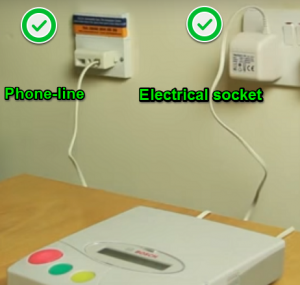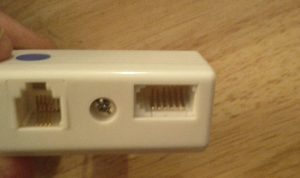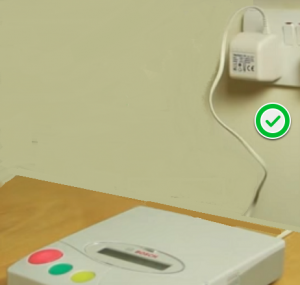Telecare equipment should be straightforward to install. Your home telecare system is made up of one or more telecare ‘peripherals’ (such as a pendant alarm) along with a two-way speech unit.
The two-way speech unit is the central piece of telecare equipment. It is the part that calls through to a 24-hour telecare monitoring centre if you need help. It is usually located in your hallway or bedroom. Your pendant alarms or other telecare equipment all connect by radio signal to the two-way speech unit. Therefore no new wiring should be required in your home. The two-way speech unit is installed by simply plugging it into a standard electrical socket and phone-line.
To test if your telecare equipment is working, you can press the button on your pendant alarm, from anywhere in your home. It should transmit a signal the base-unit and you will be put through to the 24/7 monitoring centre.
If you have a phone-line in your home
If you have a analogue home phone-line (with no broadband) then your two-way speech unit will generally plug into your phone-line socket, in the same way as your home phone does.

However, if you are using the same phone-line socket for the two-way speech unit and phone, an adaptor such as the one shown below will be needed. The telecare unit simply plugs into one side of the adapter and your home phone plugs into the other. The adapter then connects into the phone-line socket in you wall. This means your home telephone can still be used. However be aware that if the telephone is being used (if you are on a call) or if it is off the hook, your telecare alarm may not work. You can verify this with your telecare supplier.
If you have a phone-line in your home (with broadband)
If you have broadband in your home, then a small box-shaped device called a micro-filter may need to be positioned between the phone socket and the telecare base unit, connecting the two . You should always check whether or not this is needed with your alarm supplier before installing your telecare alarm base-unit.

A standard home phone two-way adapter can be used to connect your telecare system if you have an analogue phone-line with no broadband
A number of other telecare devices can connect wirelessly to you two-way speech unit (but always check first with your telecare supplier that any other telecare equipment is compatible). If you are buying additional telecare devices from your supplier always make sure they carry out a test once the new telecare equipment is installed, to ensure it is connecting to the two-way speech unit and going through to the 24-hour monitoring centre.
If you do not have a home phone-line
If you do not have a home phone-line, a ‘GSM’ telecare system can be used. This works in much the same way as a standard telecare two-way speech unit. It is also installed in the same way as a standard telecare two-way speech unit, but with only an electrical socket needed.
This is because the telecare system also uses a mobile SIM card to connect to the monitoring centre over a mobile/cellular network. The GSM unit dials through to the monitoring centre in a similar way as a mobile phone makes calls.

A GSM telecare two-way speech unit does not require a home phone-line. It works using a mobile SIM card
Because these type of alarms work by using a mobile SIM card over a cellular network, rather than over your home phone-line, the GSM telecare units are usually a bit more expensive. Suppliers generally provide a SIM card with the unit, however some telecare providers will let you use your own SIM card. If you choose to do so, then it’s best to us a contract SIM. That way there should always be credit for an emergency call.
A roaming SIM card is probably the best type to opt for if you are using a GSM telecare unit. Roaming SIM cards (also sometimes called world SIM cards) work in the same way as normal SIM cards, but will search for the strongest network signal. That means that if one mobile operator’s service is down temporarily, the SIM will attach to a another mobile operator. In contrast, if you use a single network SIM, it won’t have the capacity to latch on to another mobile operator in an emergency, meaning the call will have a higher chance of failing.
To get telecare equipment for your home, you can have it installed by your telecare supplier or by ordering online. You can find out more about the different options for getting telecare equipment here.
Note: The above is for general guidance only. Always contact your telecare equipment supplier for full instructions on how to install and test any piece of telecare equipment in your home.
